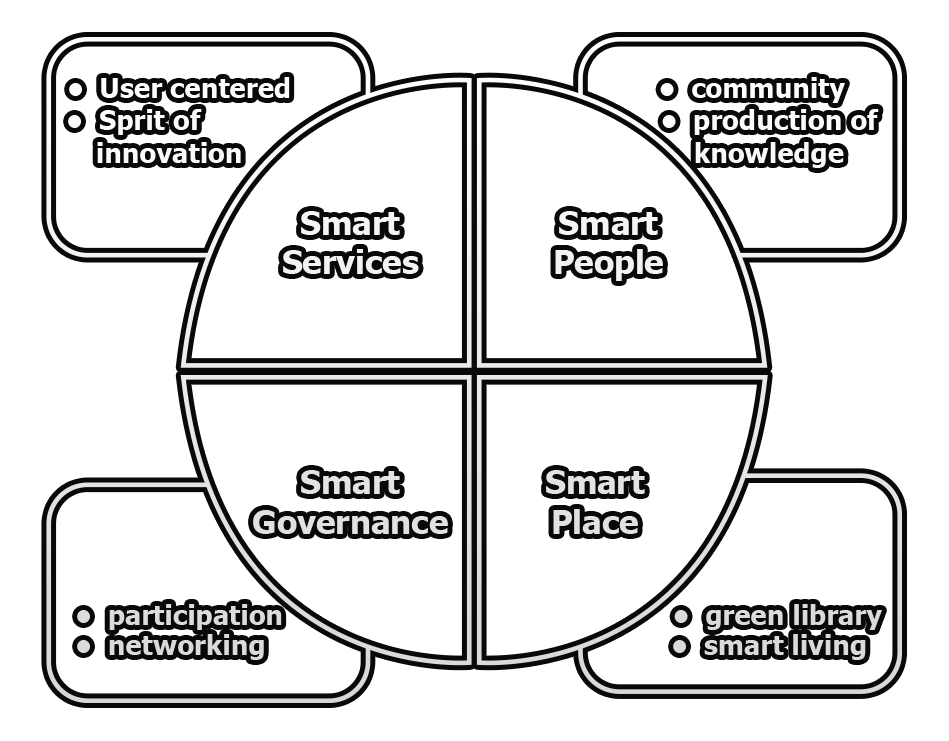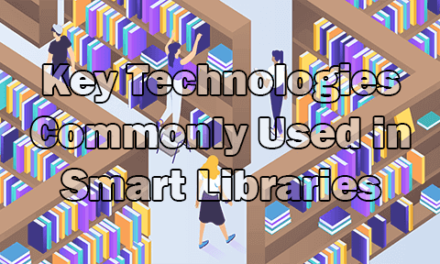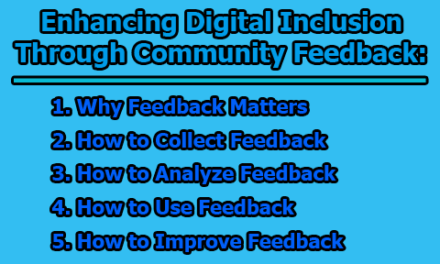Smart Library
In this digital age as we are moving forward we should take advantage of smart technology to modernize the libraries. These smart technologies encourage more people to use the library. It is a system well equipped with smart technology that is fully dedicated to helping library users so that they can fulfill their requirements without the help of the staff and without wasting their valuable time. A smart library (SL) enables remote control of the library building including automatic doors, public access computers, and a self-service kiosk. It is a system developed to support library users. This system extends the library hours and makes the users able to use library services according to their convenience. The concept of the SL has been discussed globally in different contexts and under different names. Consequently, there is a range of conceptual variants generated by replacing “smart” with other adjectives, such as “digital”, “intelligent” and “blended”. In marketing language, smartness is centered on a user perspective.
Definition of Smart Library:
There are several definitions are being in the term “Smart Library” which all are not equally essential. Some of the necessary definitions are given below:
A smart library is a hardware and software complex with a wide range of opportunities for searching and providing necessary information to virtual users according to their inquiries and requirements.
“Smart library is a library provided services, which are interactive, innovative, informative, actual, changing and international” (Shah & Bano, 2020).
“A smart library is “to satisfy” information requests of a user, using modern information technology. It is possible to study information need of a user via instruments of information technology.” (Baryshev & Babina, 2016)
“Smart library refers to the smartness of the library building, through the integration of library building equipment, computer networks, communications technology and sensor monitoring.” (Li and Dong, 2016)
From the above definitions, we can say that a “Smart library” is a set of various electronic resources, accompanied by specialized library services, which are provided by the use of information and communication technologies.
Four dimensions of the smart library:
Smart Services: The first dimension can be described as the application of the “spirit of innovation” of smart cities to the development of modern library services. Smart libraries present technological innovation as smart services, such as RFID, mobile and wireless access, remote assistance, semantic web, and artificial intelligence, the Internet of Things, machine translation, voice and image recognition, natural language processing, augmented reality for delivering new experiences in enjoying cultural heritage, etc.
SL services as library-based ICT platforms, for document search, information retrieval, collaborative collection building, etc. Another characteristic of smart library services is the interoperability and interconnection with other information services. SL is an information hub connected with other libraries and urban services in a larger informational ecosystem. However, these innovative tools and services are smart only insofar as they are user-friendly and user-centered. Smartness means that the development of new tools and services is based on the assessment of real usage. The user defines the library. “Smart is more user-friendly than intelligent”. Instead of trying to adapt the user to existing library services, smart libraries are required to adapt themselves to the user’s needs. The assessment of real usage can include mobile crowdsensing in order to support smart mobility, usage of library space, access to library facilities, agile management, UX design, and personalized information discovery based on recommendations (algorithms).
Smart People: Smart libraries are made for and with smart people. In the specific environment of libraries, we can translate this concept of smart people as follows, on two levels:
- Smart community: The concept of smart people does not only include the smart citizen, user of SL services, but also the staff of the library, their skills, and job development. The library staff is part of the smart people, for instance, when it comes to the production and analysis of information and data (data librarian) or to the control of discovery tools.
- Production of knowledge: The library user is a producer of knowledge or co-producer alongside other users and/or the staff. Creation, enrichment, and sharing of information and knowledge are other terms that describe the vision of the smart library user’s role and action. This vision is converging with the conceptualization of the library as a “platform of the commons”, where knowledge is produced by and with citizens.
Smart Place: The third dimension refers to the library as a building and as a place. In a general manner, this dimension can be described as “smart environment” and environmental monitoring. In fact, we can distinguish two different aspects:
The first aspect is ecology, and similar to the concept of the green library mentioned before. It covers, for instance, compliance with sustainable building rating systems, waste management, the attractiveness of natural conditions, lack of pollution, sustainable management of resources, etc. One part is sustainable architecture and engineering. The other is ecological functioning and management. Together, they represent the libraries’ contribution to sustainable development and biodiversity.
The second aspect can be described as smart living related to buildings and means, for instance, building monitoring and control, monitoring of electrical devices, personal safety, and a healthy environment for the staff, as well as for the public. This aspect includes innovations that contribute to improving the quality of life and attractiveness of the library as a building and as a place. We can see similarities with the “hard” attributes of the library as a third place, with its architectural design, functioning, etc.
Smart Governance: The last dimension of the smart library is institutional and political. It includes all library features that correspond to the concept of “smart governance” in the city, which encapsulate, for instance, collaboration, cooperation, partnership, citizen engagement, and participation. At the heart of smart governance is the community, which understands the potential of information technology for the development of the library, as a means of reinvesting libraries for a new ecosystem. “Institutional preparation and community governance are essential to the success of smart community cities”. Again, we can distinguish two aspects.
- Smart management: SL management can include several initiatives, like increasing transparency of the administration and management system, user participation in decision-making processes, automatic and optimized administration procedures, real-time analysis of big data on library usage to improve the quality of library strategies, and decision-making, etc. The library user becomes a stakeholder of the library and takes part in the library management and administration.
- Smart networking: the second aspect of smart governance is networking or, in other words, the library’s openness and embeddedness in its social and cultural environment. Also, decisions should be taken collectively, not as an isolated institution but as an element in the larger ecosystem of other libraries, information hubs, and third places.
The keyword of smart governance is collective intelligence, based on shared responsibilities between the library staff, the library community, and other institutions. “Collective coherence will be a critical success factor in gaining future traction in public policy”. Smart governance is one way to increase social coherence. The public library can contribute in many ways to the local policy, with contributions to culture and education, filling the gap in information literacy, and improving the access to relevant information and social services.
Finally, we can say, going smart and eco-friendly, sustainable information systems are the need of the present generation which calls for immediate concentration. In this new dimension of information technology, the libraries and information centers necessitate enhancing the quality of their services by successfully adopting digital technology. The construction of a Library is a one-time investment and we have very well known that library always facing problems like space, funds, skill manpower, etc. just like these books are also facings problems from dust, moisture, fungus and access to location, etc. and they want proper care like others things. Smart construction where minimize electricity consumption and maximize the use of renewable sources like air, sunlight, wooden construction, water conservation, etc. In this present century, it is required for librarians to adopt smart technology with smart construction.
References:
- Cao, G., Liang, M., & Li, X. (2018). How to make the library smart? The conceptualization of the smart library. The Electronic Library, 36(5), 811–825.
- Schöpfel, J. (2018). Smart Libraries. Infrastructures, 3(4), 43.
- Shah, A., & Bano, R. (2020). Smart library: Need of 21 st Century. Library Progress (International), 40(1), 1.
- Baryshev, R. A., & Babina, O. I. (2016). Smart library concept in a Siberian federal university. International Journal of Applied and Fundamental Research, (1), 16-16.
- Li, H., and Dong, F. (2016), “Research on the implementation strategy of the smart library services”, Library, Vol. 260 No. 5, pp. 80-84.
You may also read the following article: Key Technologies Commonly Used in Smart Libraries

Library Lecturer at Nurul Amin Degree College










